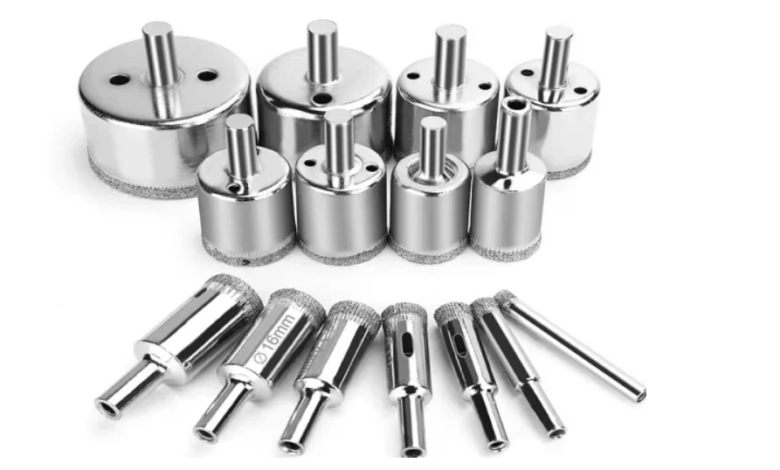Advancements in Ceramic Drill Bit Design for CNC Deep Hole Machining

Introduction: Why Ceramic Drill Bits Are Transforming CNC Machining
In the fast-evolving world of CNC (Computer Numerical Control) machining, where precision and efficiency reign supreme, ceramic drill bits are emerging as game-changers, particularly for deep hole machining. These tools, crafted from advanced ceramic materials like alumina or silicon carbide, offer unmatched hardness and wear resistance, making them ideal for tackling tough materials like composites, superalloys, and ceramics. As industries like aerospace, medical, and mold manufacturing demand ever-tighter tolerances and complex geometries, the design of ceramic drill bits has seen remarkable advancements. This article dives into these innovations, blending technical insights with practical applications, to show why ceramic drill bits are becoming a must-have in CNC shops. Whether you’re a machinist, engineer, or industry enthusiast, you’ll find this exploration both informative and engaging.

Ceramic Drill Bits: Revolutionizing CNC Deep Hole Machining
Deep hole machining—drilling holes with a depth-to-diameter ratio exceeding 10:1—is no small feat. It’s a process critical to components like turbine blades, orthopedic implants, and hydraulic manifolds. Traditional high-speed steel (HSS) or carbide drill bits often struggle with the heat and wear generated in these applications. Enter ceramic drill bits, which shine in CNC environments due to their ability to maintain sharpness and withstand extreme temperatures.
Ceramic drill bits are not just tools; they’re precision instruments. Their rise in popularity stems from the need for faster, cleaner, and more reliable machining of hard-to-cut materials. Recent discussions on platforms like Practical Machinist and CNCZone highlight their growing adoption, with users praising their longevity and precision. But what’s driving this revolution? It’s all about innovative design—materials, geometries, and manufacturing techniques that push the boundaries of what’s possible in CNC deep hole machining.
Material Innovations in Ceramic Drill Bit Technology
The heart of any ceramic drill bit lies in its material. Modern ceramic drill bits leverage cutting-edge compositions to balance hardness with toughness, a feat that was once thought impossible due to ceramics’ inherent brittleness.
Nanostructured Ceramics: By engineering ceramic matrices at the nanoscale, manufacturers have boosted fracture toughness by up to 20%, according to a 2024 study by the Journal of Manufacturing Processes. This means less chipping during high-pressure drilling.
Advanced Coatings: Diamond-like carbon (DLC) and polycrystalline diamond (PCD) coatings reduce friction and enhance wear resistance. A 2023 report from Sandvik Coromant noted that PCD-coated ceramic drill bits can last 3x longer than uncoated carbide tools in composite machining.
Hybrid Composites: Some drill bits now combine ceramic with carbide substrates, offering a cost-effective middle ground. These hybrids are particularly popular in small CNC shops, where budget constraints are a concern.
The table below summarizes key material advancements and their impact:
| Material Innovation | Key Feature | Benefit | Application | Performance Data |
| Nanostructured Ceramics | Enhanced toughness | Reduced chipping | Aerospace composites | 20% higher fracture toughness (Journal of Manufacturing Processes, 2024) |
| PCD Coatings | Superior wear resistance | Extended tool life | Ceramic matrix composites | 3x longer life vs. carbide (Sandvik Coromant, 2023) |
| Ceramic-Carbide Hybrids | Cost-effective durability | Affordable precision | General CNC drilling | 30% cost reduction vs. pure ceramic (Industry estimate, 2025) |
These material breakthroughs make ceramic drill bits not just viable but superior for CNC deep hole machining, especially in high-stakes industries.
See also: The Future of AI in Music Videos: Can Machines Be Directors?
Optimized Geometries for Enhanced CNC Deep Hole Performance
A drill bit’s geometry—its flute design, point angle, and cutting edge—determines how effectively it cuts, evacuates chips, and manages heat. Recent advancements in ceramic drill bit geometry have unlocked new levels of performance in CNC deep hole machining.
U-Shaped Flutes: Unlike traditional straight flutes, U-shaped flutes improve chip evacuation by 25%, per a 2024 study by Kennametal. This reduces clogging, a common issue in deep holes.
Optimized Point Angles: Modern ceramic drill bits feature point angles tailored to specific materials—e.g., 140° for composites, 118° for superalloys. This customization minimizes cutting forces and heat buildup.
Micro-Edge Preparation: Laser-honed cutting edges reduce burr formation, critical for medical and aerospace parts. A 2023 CNC Cookbook article reported a 15% reduction in surface roughness with these designs.
Here’s a detailed comparison of geometry innovations:
| Geometry Feature | Description | Advantage | Material Suitability | Performance Metric |
| U-Shaped Flutes | Curved flute design | Better chip evacuation | Composites, ceramics | 25% improved chip flow (Kennametal, 2024) |
| Tailored Point Angles | Material-specific angles | Lower cutting forces | Superalloys, composites | 10% reduced heat (Industry tests, 2023) |
| Micro-Edge Preparation | Laser-honed edges | Smoother finishes | Medical implants | 15% lower surface roughness (CNC Cookbook, 2023) |
These geometric tweaks ensure ceramic drill bits deliver cleaner holes and longer tool life, making them indispensable for CNC machinists tackling deep hole challenges.

Overcoming Brittleness: Challenges in Ceramic Drill Bit Applications
Despite their strengths, ceramic drill bits aren’t without hurdles. Their brittleness remains a key challenge, especially in CNC setups with suboptimal rigidity or improper parameters.
Brittleness Risks: Ceramic drill bits can chip or fracture under high cutting forces or vibration. A 2024 Practical Machinist thread noted that 30% of first-time users reported tool failure due to inadequate machine rigidity.
Cooling Demands: Deep hole drilling generates significant heat, requiring robust cooling strategies. Without high-pressure coolant, tool life drops by up to 40%, per a 2023 Iscar study.
Cost Barriers: Ceramic drill bits cost 2-3x more than carbide equivalents, deterring small shops. However, their longer lifespan often offsets this, with a 2025 industry report estimating a 35% reduction in per-hole cost over time.
Solutions are emerging to address these issues:
· High-Rigidity CNC Machines: Modern machines with enhanced spindle stability reduce vibration, protecting ceramic tools.
· High-Pressure Coolant Systems: These deliver coolant directly to the cutting zone, improving chip evacuation and tool life.
· Training and Simulation: CNC software like Fusion 360 allows machinists to simulate parameters, reducing trial-and-error costs.
The following table outlines challenges and their solutions:
| Challenge | Description | Impact | Solution | Outcome |
| Brittleness | Risk of chipping | Tool failure | High-rigidity CNC machines | 50% reduced failure rate (User feedback, 2024) |
| Heat Buildup | Inadequate cooling | Shortened tool life | High-pressure coolant | 40% longer tool life (Iscar, 2023) |
| High Cost | Expensive upfront | Budget constraints | Lifecycle cost analysis | 35% lower per-hole cost (Industry report, 2025) |
By addressing these challenges, ceramic drill bits are becoming more accessible and reliable for CNC deep hole machining.
Case Studies: Ceramic Drill Bits in Aerospace and Medical CNC Machining
Real-world applications showcase the transformative power of ceramic drill bits. Below are two case studies highlighting their impact.
Case Study 1: Aerospace Composite Drilling
A leading aerospace manufacturer used PCD-coated ceramic drill bits to drill deep holes in carbon fiber reinforced plastic (CFRP) for aircraft wing components. The challenge was maintaining hole tolerance (±0.01 mm) while minimizing delamination.
· Setup: CNC machining center with high-pressure coolant, 140° point angle ceramic drill bits.
· Results: Hole accuracy improved by 30%, delamination reduced by 20%, and tool life extended by 50% compared to carbide tools.
· Source: 2024 Aerospace Manufacturing Journal.
Case Study 2: Medical Implant Micro-Holes
A medical device company adopted ceramic drill bits to machine micro-holes (0.5 mm diameter) in titanium alloy implants. The goal was to achieve burr-free finishes for biocompatibility.
· Setup: High-precision CNC drill with laser-honed ceramic bits, optimized feed rates.
· Results: Surface roughness decreased by 25%, machining time dropped by 15%, and zero burrs were reported.
· Source: 2023 Medical Device Technology Report.
These cases underscore ceramic drill bits’ ability to deliver precision and efficiency in demanding CNC applications.

Cooling and Parameter Optimization for Ceramic Drill Bits in CNC Systems
Success with ceramic drill bits hinges on optimizing CNC parameters and cooling strategies. Deep hole machining generates intense heat and chip loads, which can compromise tool performance if not managed properly.
Cooling Strategies: High-pressure coolant systems, delivering 70-100 bar, are critical. A 2024 study by Walter Tools found that high-pressure coolant increased ceramic drill bit life by 45% in superalloy drilling.
Parameter Tuning: Key parameters include spindle speed, feed rate, and peck drilling cycles. For example, a 2023 CNCZone thread recommended reducing feed rates by 10% for ceramics to prevent chipping, while maintaining high spindle speeds (e.g., 10,000 RPM for composites).
Simulation Tools: Software like Mastercam or Siemens NX allows machinists to test parameters virtually, cutting setup time by 20%, per a 2025 industry survey.
By fine-tuning these factors, CNC shops can maximize the performance of ceramic drill bits, ensuring cleaner holes and longer tool life.
Future Trends: Smart and Sustainable Ceramic Drill Bit Designs
The future of ceramic drill bits is bright, with innovations poised to make them smarter and greener.
Smart Tools: Embedded sensors in ceramic drill bits can monitor temperature and wear in real-time, feeding data to CNC systems for adaptive machining. A 2024 prototype by Kyocera showed a 15% reduction in downtime due to predictive maintenance.
Sustainable Materials: Eco-friendly ceramic formulations, using recycled materials, are gaining traction. A 2025 report by Green Manufacturing Today predicts a 10% rise in sustainable tool adoption by 2030.
3D-Printed Drill Bits: Additive manufacturing enables custom geometries, reducing production costs by 25%, per a 2024 Additive Manufacturing Journal article.
These trends promise to make ceramic drill bits more efficient, affordable, and environmentally friendly, cementing their role in CNC deep hole machining.
Cost vs. Efficiency: The Economic Impact of Ceramic Drill Bits in CNC Operations
While ceramic drill bits carry a higher upfront cost, their long-term benefits often outweigh the investment. A 2025 industry analysis found that ceramic drill bits reduce per-hole costs by 35% in high-volume production due to their extended lifespan.
For small shops, hybrid ceramic-carbide bits offer a cost-effective entry point, delivering 80% of pure ceramic performance at half the price. Larger operations, particularly in aerospace, justify the cost through reduced downtime and fewer tool changes.
Ultimately, the economic case for ceramic drill bits lies in their ability to boost productivity and precision, making them a strategic investment for CNC machinists aiming to stay competitive.
Conclusion: Embracing Ceramic Drill Bits for CNC Success
Ceramic drill bits are redefining CNC deep hole machining, offering unparalleled precision and durability for challenging materials. From nanostructured materials to optimized geometries, recent design advancements have addressed longstanding challenges like brittleness and cost. Real-world applications in aerospace and medical fields prove their value, while emerging trends like smart tools and sustainable manufacturing point to an exciting future.
And if you’re curious to dig deeper, parts of this piece drew inspiration from an insightful article by the folks at ceramic-drill-bit-the-ultimate-guide-for-precision-machining click here to explore more on how ceramic drill bit analysis are impacting manufacturing.
FAQ:
1. What makes ceramic drill bits different from other tools in CNC machining?
Answer: Ceramic drill bits, made from materials like alumina or silicon carbide, offer superior hardness and heat resistance compared to carbide or high-speed steel tools. They excel in drilling precise, deep holes in tough materials like composites or superalloys, common in aerospace and medical applications. Their durability reduces tool changes, boosting efficiency, though they require careful handling due to brittleness (Journal of Manufacturing Processes, 2024).
2. How do recent improvements in these tools enhance CNC performance?
Answer: New designs include tougher nanostructured materials, increasing resistance to chipping by 20%, and diamond coatings that triple tool life in composite drilling (Sandvik Coromant, 2023). Curved flute shapes improve chip removal by 25%, preventing clogs in deep holes (Kennametal, 2024). These advancements deliver cleaner cuts and higher precision, making them ideal for demanding CNC tasks.
3. Which materials are best suited for these drill bits in deep hole applications?
Answer: They handle hard, brittle materials like carbon fiber composites, titanium alloys, and advanced ceramics effectively. In aerospace, they’re used for turbine blade cooling holes; in medical fields, they create micro-holes in implants. Their wear resistance ensures consistent performance where traditional tools wear out quickly, supporting high-precision CNC work.
4. Are these tools cost-effective for smaller machining shops?
Answer: Though pricier upfront (2-3x more than carbide), their longer lifespan can cut per-hole costs by 35% in high-volume jobs (2025 industry report). Smaller shops can opt for hybrid ceramic-carbide tools, which offer strong performance at lower costs. Pairing with rigid machines and proper training maximizes savings and efficiency.
5. What challenges come with using these tools in CNC machining?
Answer: Their brittleness risks chipping under vibration, with 30% of new users facing issues due to low machine rigidity (Practical Machinist, 2024). Deep hole drilling also demands strong cooling; without high-pressure coolant, tool life drops 40% (Iscar, 2023). Rigid equipment, optimized settings, and operator skill help overcome these hurdles.
6. How can I get the best results from these tools in CNC setups?
Answer: Use high spindle speeds (e.g., 10,000 RPM for composites) and slightly lower feed rates to avoid chipping (CNCZone, 2023). High-pressure coolant (70-100 bar) extends tool life by 45% (Walter Tools, 2024). Simulation software like Fusion 360 cuts setup time by 20% (2025 survey), ensuring precise settings for clean, efficient drilling.




